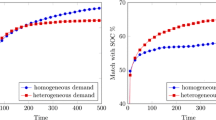Abstract
When the full stock of a new product is quickly sold in a few days or weeks, one has the impression that new technologies develop and conquer the market in a very easy way. This may be true for some new technologies, for example the cell phone, but not for others, like the blue-ray. Novelty, usefulness, advertising, price, and fashion are the driving forces behind the adoption of a new product. But, what are the key factors that lead to adopt a new technology? In this paper we propose and investigate a simple model for the adoption of an innovation which depends mainly on three elements: the appeal of the novelty, the inertia or resistance to adopt it, and the interaction with other agents. Social interactions are taken into account in two ways: by imitation and by differentiation, i.e., some agents will be inclined to adopt an innovation if many people do the same, but other will act in the opposite direction, trying to differentiate from the “herd”. We determine the conditions for a successful implantation of the new technology, by considering the strength of advertising and the effect of social interactions. We find a balance between the advertising and the number of anti-herding agents that may block the adoption of a new product. We also compare the effect of social interactions, when agents take into account the behavior of the whole society or just a part of it. In a nutshell, the present model reproduces qualitatively the available data on adoption of innovation.
Similar content being viewed by others
References
E.M. Rogers, Diffusion of Innovations, 5th edition (Free Press, 2003)
P. Brimelow, The silent boom, http://www.forbes.com/forbes/1997/0707/6001170a.html (Forbes, 1997)
M. Cox, R. Alm, You are what you spend (New York Times, 2008)
A. Thierer, On Measuring Technology Diffusion Rates, http://techliberation.com/2009/05/28/on-measuring-technology-diffusion-rates/ (2009)
D. Algoso, What does complexity mean? What do we do about it? Find What Works, http://findwhatworks.wordpress.com/tag/technology-adoption/ (2010)
A. Mas-Collel, M.D. Whiston, J.R. Green, Microeconomic Theory (Oxford University Press, New York, 1995)
W.J. Nuttall, T. Zhang, D.J. Hamilton, F.A. Roques, Sociophysics Simulations of Technology Adoption and Consumer Behavior, Second International Symposium on Engineering Systems MIT (Cambridge, Massachusetts, 2009) http://ima.ac.uk/papers/zhang2009.pdf
V. Semeshenko, Interacting learning agents: Models, Simulations and Experiments (VDM Verlag, 2009) ISBN-13: 978-3639190946
J.-P. Nadal, D. Phan, M.B. Gordon, J. Vannimenus, Quantitat. Finance 5, 557 (2005)
M. Kuperman, G. Abramson, Phys. Rev. Lett. 86, 2909 (2001)
C. Castellano, S. Fortunato, V. Loreto, Rev. Mod. Phys. 81, 591 (2009)
M.F. Laguna, S.R. Gusman, G. Abramson, S. Gonçalves, J.R. Iglesias, Physica A 351, 580 (2005)
S. Galam, Int. J. Mod. Phys. C 19, 409440 (2008)
M.B. Gordon, J.-P. Nadal, D. Phanc, J. Vannimenus, Physica A 356, 628640 (2005)
S. Galam, A. Vignes, Physica A 351, 605 (2005)
T. Bouzdine-Chameeva, S. Galam, Adv. Compl. Syst. 14, 871885 (2011)
S. Galam, Physica A 390, 3036 (2011)
Z. Abbassi, C. Aperjis, B.A. Huberman, Swayed by Friends or by the Crowd? arXiv:1111.0307v2 (2011)
Author information
Authors and Affiliations
Corresponding author
Rights and permissions
About this article
Cite this article
Gonçalves, S., Laguna, M.F. & Iglesias, J.R. Why, when, and how fast innovations are adopted. Eur. Phys. J. B 85, 192 (2012). https://doi.org/10.1140/epjb/e2012-30082-6
Received:
Revised:
Published:
DOI: https://doi.org/10.1140/epjb/e2012-30082-6




